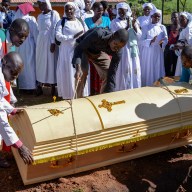I’ve been in Buenos Aires for less than an hour. Already I’m sensing the bizarre atmosphere of addiction and romance that’s at the heart of the world of tango. “It used to be just Argentines who danced tango,” my taxi driver is enthusing. “Now people come from Australia, Canada, Europe … even Korea and Japan.”
Tango attracts particularly dedicated followers and for millions of people, the Argentine capital has become the ultimate place of pilgrimage.
Private tango instruction rather than group classes is considered a must, so I’m partnered with a fellow tango virgin, Turkish TV presenter Asli Pelit, for my first foray into the dance. We take our first tentative baby steps as tangueros on Susana Mirosmik’s little terrace as steaks sizzle on the parilla (barbecue), which will be a welcome reward for our efforts.
Mirosmik has been dancing tango for more 20 years and is one of the most well-known faces in the tango scene here: “You must learn to walk before you can dance,” she says as she shows us how to move. “A graceful walk is the very basics of the dance.”
We move in carefully measured circles around the terrace and begin to grasp the meditative aspect that is the essence of the tango experience.
Some come to Buenos Aires to watch spectacular tango exhibitions or to spend a fortune on months of private lessons. Some dedicated pilgrims come simply to immerse themselves in the serenity of the milongas. These are traditional local dances where the purest tango can be found, and Mirosmik guides us to a milonga at La Nacional. The men affect the stance of gentleman matadors and the women demure debutantes. On the dance floor, any exuberant exhibitionism is frowned upon. Poise and reserve are the keys to acceptance at a traditional milonga.
I’m aware that elegance and matador poise are yet to establish a permanent place in my psyche but, under Mirosmik’s guidance, I’m at least able to appreciate the understated subtleties of milonga footwork.
I might only be on my first steps to tango expertise, but it feels good to be able to say that I have at least learned to really walk in Buenos Aires.
Takes three to tango
Learn: Susana Mirosmik is arguably the best contact to set up tango lessons in Buenos Aires. Her company, Su Tours, can also arrange everything from tango instruction to accommodation and weeklong tours of upcountry Argentina. (www.sutours.blogspot.com)
Parties: Some of the most recommended milongas — traditional local tango dances — are at La Nacional, El Arranque and La Ideal. Milongas cost around $5 admission and many include an hour of tuition at the beginning. (www.buenosairesmilongas.com)
Shows: The most famous and spectacular tango shows can be seen at Rojo Tango (from $220, www.rojotango.com), La Ventana Tango (from $90, www.tangotix.com) and La Esquina Carlos Gardel (www.esquinacarlosgardel.com.ar).
Traveler tips
Shop: Corrientes Avenue is the Argentine Broadway and it’s a wonderful place to shop for books and music or check out the latest creations from some of Buenos Aires’ finest designers.
Stay: Hotel Mansion Dandi Royal is a wonderfully atmospheric 30-room boutique hotel full of art nouveaux decor and saturated with the romantic atmosphere for tango. The hotel even has its own “tango academy.” (www.mansiondandi royal.com).
Do: A soccer match at the incredible Boca Stadium is something not to be missed. When the Boca Juniors supporters start to jump, the stadium actually vibrates under your feet. For tickets visit www.tangol.com.
















